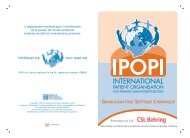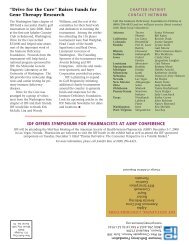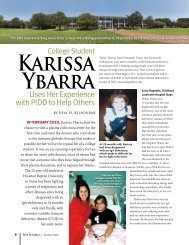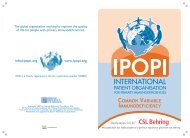IDF Patient & Family Handbook for Primary Immunodeficiency ... - IDFA
IDF Patient & Family Handbook for Primary Immunodeficiency ... - IDFA
IDF Patient & Family Handbook for Primary Immunodeficiency ... - IDFA
You also want an ePaper? Increase the reach of your titles
YUMPU automatically turns print PDFs into web optimized ePapers that Google loves.
IgG Subclass Deficiency and Specific Antibody Deficiency 51<br />
Definition of Subclass Deficiency<br />
Antibodies are made of proteins called<br />
immunoglobulins. There are five types or classes<br />
of immunoglobulin: IgG, IgA, IgM, IgD and IgE<br />
(see chapter titled The Immune System and<br />
<strong>Primary</strong> <strong>Immunodeficiency</strong> Diseases). Most of<br />
the antibodies in the blood and the fluid that<br />
bathes the tissues and cells of the body are of<br />
the IgG class. The IgG class of antibodies is<br />
itself composed of four different subtypes of IgG<br />
molecules called the IgG subclasses. These are<br />
designated IgG1, IgG2, IgG3 and IgG4. <strong>Patient</strong>s<br />
who suffer recurrent infections because they<br />
lack, or have very low levels of, one or two IgG<br />
subclasses, but whose other immunoglobulin<br />
levels, including total IgG, are normal, are said to<br />
have a selective IgG subclass deficiency.<br />
While all the IgG subclasses contain antibodies,<br />
each subclass serves somewhat different<br />
functions in protecting the body against infection.<br />
For example, the IgG1 and IgG3 subclasses<br />
are rich in antibodies against proteins such<br />
as the toxins produced by the diphtheria and<br />
tetanus bacteria, as well as antibodies against<br />
viral proteins. In contrast, antibodies against the<br />
polysaccharide (complex sugar) coating (capsule)<br />
of certain disease-producing bacteria (e.g. the<br />
pneumococcus and Haemophilus influenzae) are<br />
predominantly of the IgG2 type. Some of the IgG<br />
subclasses can easily cross the placenta and enter<br />
the unborn infant’s bloodstream, while others do<br />
not. Antibodies of certain IgG subclasses interact<br />
readily with the complement system, while others<br />
interact poorly, if at all, with the complement proteins.<br />
Thus, an inability to produce antibodies of a specific<br />
subclass may render the individual susceptible to<br />
certain kinds of infections but not others.<br />
The IgG circulating in the bloodstream is 60-70%<br />
IgG1, 20-30% IgG2, 5-8% IgG3 and 1-3% IgG4.<br />
The amount of the different IgG subclasses<br />
present in the bloodstream varies with age. For<br />
example, IgG1 and IgG3 reach normal adult levels<br />
by 5-7 years of age while IgG2 and IgG4 levels<br />
rise more slowly, reaching adult levels at about<br />
10 years of age. In young children, the ability to<br />
make antibodies to the polysaccharide coatings<br />
of bacteria, antibodies that are most commonly<br />
of the IgG2 subclass, develops more slowly than<br />
the ability to make antibodies to proteins. These<br />
factors must be taken into account be<strong>for</strong>e an<br />
individual is considered to be abnormal, either<br />
by virtue of having a low IgG subclass level or an<br />
inability to make a specific type of antibody.<br />
Clinical Presentation of Subclass Deficiency<br />
Recurrent ear infections, sinusitis, bronchitis and<br />
pneumonia are the most frequently observed<br />
illnesses in patients with IgG subclass deficiencies.<br />
Both males and females may be affected. Some<br />
patients will show an increased frequency of<br />
infection beginning in their second year of life. In<br />
other patients the onset of infections may occur<br />
later. Often a child with IgG subclass deficiency<br />
will first come to the physician’s attention because<br />
of recurrent ear infections. Somewhat later in<br />
life, recurrent or chronic sinusitis, bronchitis<br />
and/or pneumonia may make their appearance.<br />
In general, the infections suffered by patients<br />
with selective IgG subclass deficiencies are not<br />
as severe as those suffered by patients who<br />
have combined deficiencies of IgG, IgA and IgM<br />
(<strong>for</strong> example X-linked agammaglobulinemia or<br />
common variable immunodeficiency). Very rarely,<br />
IgG subclass deficient patients have suffered<br />
recurrent episodes of meningitis or bacterial<br />
infections of the bloodstream (e.g. sepsis).<br />
Selective IgG1 subclass deficiency is very<br />
rare. IgG2 subclass deficiency is the most<br />
frequent subclass deficiency in children, while<br />
IgG3 subclass deficiency is the most common<br />
deficiency seen in adults. IgG4 deficiency most<br />
often occurs in association with IgG2 deficiency.<br />
The significance of isolated, or selective, IgG4<br />
deficiency is unclear at this time. Since many<br />
normal children under 10 years of age have<br />
undetectable IgG4, IgG4 deficiency is generally<br />
not accepted as a diagnosis in this age group.
















